|
|
Maritime Topics On Stamps :
|
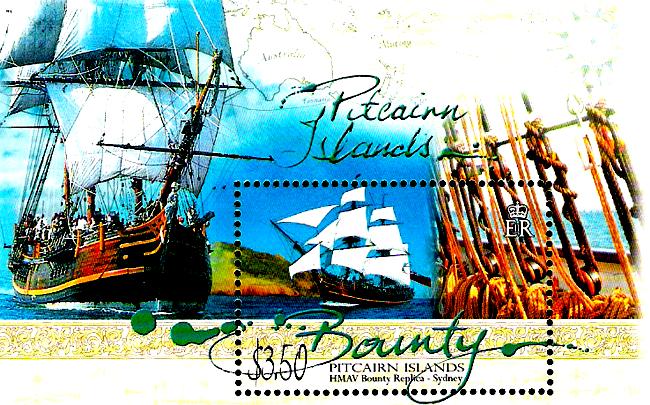
Mutiny on the 'Bounty'!
Part 2.
|
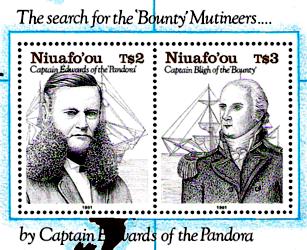
|
The British Admiralty decided that the mutineers of the "Bounty" must be caught and tried
before a court martial.
Captain Edward Edwards was given the frigate HMS "Pandora" and ordered to catch the mutineers.
On the left hand stamp there is captain Edwards, on the right hand stamp Captain Bligh.
|
The "Pandora" was whipped as a three mast fullrigger.
She launched in Deptford (England) in may 1779.
She was 38.5 m long, 9.8 m wide, 520 tons.
She was equipped with 24 cannons (20 six pounder and four eighteen pounder)
and sailed by a crew of 126 men.
|
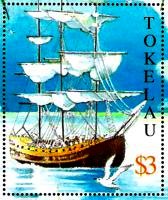
|
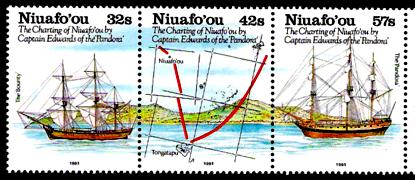
|
In November 1790 the "Pandora" left England , rounded Cape Hoorn, sailed into the Pacific.
Actually she passed the Pitcairn Island, out of sight and without Edwards knowing it.
Pitcairn Island was the refuge of the "Bounty" mutineers who didn't stay on Tahiti.
The "Pandora" reached Tahiti in early March 1791.
|
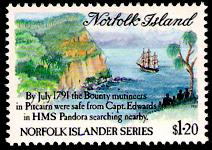
|
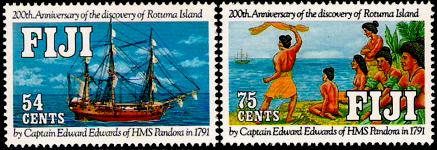
|
As soon as the boat had dropped anchor in the bay of Matavai, three crew members of the "Bounty"
voluntarily came on board. Edwards had them arrested immediately. The ship's carpenter erected
a prison for the mutineers on the quarterdeck. It was a 3.4 × 5.5 m wide massive structure,
jokinglay called "the box of the Pandora". At times 14 men were jailed!
The remaining crew members of the ""Bounty" had tried to hide, but eventually were all caught
within two weeks of intensive search.
Then Edwards went on searching for the "Bounty". The "Pandora" crossed the South Seas for
four months, however in veign without result.
The only meager result was that a few then still unknown islands were discovered.
Edwards finally called it a day, gave up the search and returned to England.
|
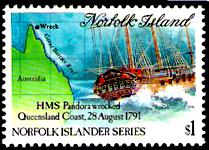
|
On August 29, 1791, the "Pandora" touched ground on the Great Barrier Reef before Australia. The leak was too large
to keep the "Pandora" afloat with her pumps, and she sank.
31 sailors and four chained mutineers drowned. 99 survived, including Captain Edwards,
rescuing themselves in four open boats.
After a 1000 miles long, adventurous voyage they
finally reached the Dutch colony on Timor, where they arrived on September 16th, 1791.
| |
On board of Dutch East Indies merchant ships captain Edwards, the healthy heads of his crew,
and the surviving ten "Bounty" mutineers sailed back to England.
|

|
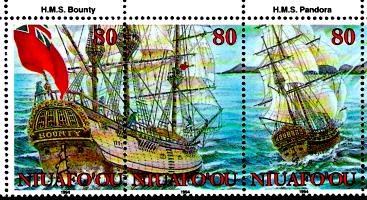
|
In September 1792 the 10 mutineers who Edwards had brought back, were prosecuted.
Four were acquitted.
The remaining six were sentenced to death by hanging. Of these, three were pardoned by the king.
The other three were hanged on 29 October 1792, from a spar of the warship HMS "Brunswick"
in the port of Portsmouth.
Edwards too was tried before a military court for the loss of the "Pandora".
He was acquitted of any negligence, because he had sent a dinghy in advance, to scout
about the coral reefs.
|
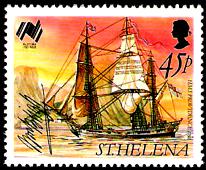
|
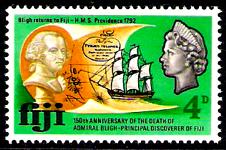
|
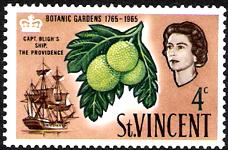
|
William Bligh was trusted with a second bread fruit mission.
He was given the newly built HMS "Providence". To avoid repeating a "Bounty" disaster"
the HMS "Assistance" escorted him.
The "Providence" was rigged as a three mast-full rigger.
In April 1791 she was put into service.
Her length was 32.6 m, her width 8.8 m, her loading capacity 420 tons.
She was armed with 16 guns and 14 swivel Basses, and sailed by a crew of about 150 men.
On the three stamps, next to the Queen, there are the HMS "Providence",
William Bligh and a bread fruit shrub.
|

|
The voyage was successfully finished without any major incidents.
They brought bread fruit plants from Tahiti to St. Vincent and Jamaica.
The stamps above from left to right:
Captain W. Bligh, HMS "Providence", HMS "Assistance", sailors loading bread fruit plants,
and a naval officer, overseeing the loading of plants, water drums and proviant boxes.
The legs of the journey:
- 3 Aug. 1791: Departure from Spithead
- 9 Apr. 1792: Arrival in Tahiti
- 19 July 1792: Departure from Tahiti
- 22 Jan. 1793: Arrival in St. Vincent (Westind. Islands)
- 5 Feb. 1793: Arrival in Jamaica
- 7 Aug. 1793: Arrival in Deptford, England
|
1801 Bligh, along with Nelson, took part in the Battle of Copenhagen.
He was praised because of his exceptional bravery and became governor of New South Wales
in 1805.
He stood in court once, because of his tone with a subordinate officer.
He survived two more mutinies, was rehabilitated in both cases, and at last as promoted
to the rank of Vice Admiral.
From 1810 on however, he did not receive any more commands.
He died in December 1817.
On this stamp is shown Bligh's grave in St. Mary's Church, Lambeth, London SE.
|
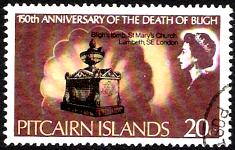
|
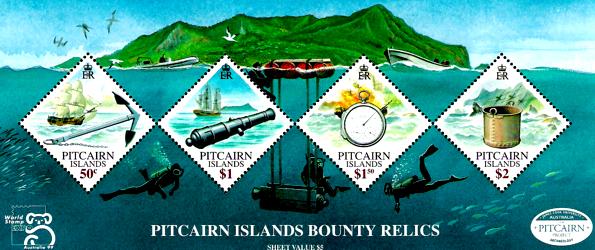
|

|
In 1957 a diving expedition looked for for the remains of the burned-out "Bounty".
The keel of the ship could still be seen. They also found a bunch of fittings, a cannon,
some cannon balls, the anchor and a boiler.
In October 1998, a group of underwater archaeologists from Australia looked at the wreck again.
Small fittings and another gun were found.
The wreck still lies in "Bounty" Bay, Pitcairn, near the landing site, in three to five meters
deep water.
The wreck of the "Pandora" in 1977 was discovered. In 1979 the wreck was put under protection.
Between 1983 and 1999, there were a total of nine archaeological expeditions conducted by the
Queensland Museum in Brisbane, which also has on display the many relics.
|
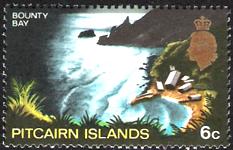
|
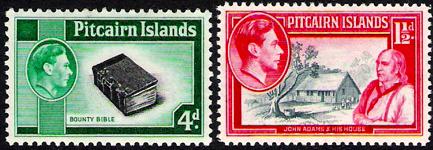
|
The stamp on the left hand side shows the "Bounty Bay" of Pitcairn island.
In the middle
the stamp shows the "Bounty Bible". It is the "Bible of the mutineers of 1789". The Bible is
now in Windsor.
The last survivor of the mutineers, John Adams, gave it to a president of the American
Seamen's Friends Society transferred.
John Adams and his house on Pitcairn are shown on the right.
| |

|
All people of Pitcairn Island are proud to be descendants of the famous "Bounty" mutineers.
Every year a "Bounty Day" is celebrated. On this Day, a model of the "Bounty" is built,
pushed into the water and burnt.
|

|
The Fletcher's Mutiny Cyclorama on Norfolk Island is a 360 degree panoramic picture
of the Mutiny on the "Bounty". With its 3D effects, it is the main tourist attraction.
Norfolk Island has issued a set of five stamps, two of which are shown above
("Collecting Breadfruit at Tahiti" und "Burning the Bounty at Pitcairn").
|
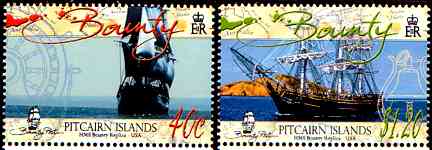
|
So far five movies have been produced on "The mutiny on the "Bounty". To that end two replicas of the
"Bounty" were built.
|
"Bounty", replica 1964 for the 1964-movie (with Trevor Howard and Marlon Brando),
is located in Oakdale, New York State (USA).
"Bounty" replica 1979, for the film with
Anthony Hopkins and Mel Gibson, is located in Sydney, Australia.
|
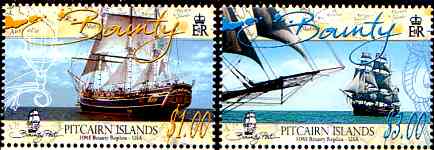
|
|